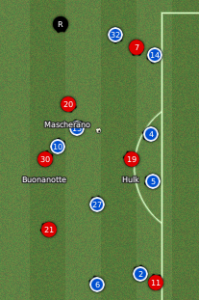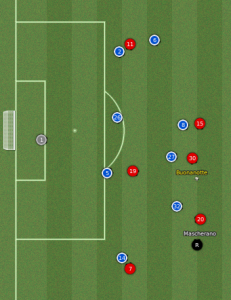When we think about modern football trends, we think about the fall of the 4-4-2, the introduction of inverted wingers and the rise of the 4-5-1. But there is one other tactical rise that seems to have been used with caution with by a few of the top managers, many abandoned just as quickly. Roma have executed the 4-6-0 brilliantly, Manchester United successfully and Barcelona with much grace. Manchester City seem to be the latest to opt for the false nine, but will these systems ever take off?
The false nine is essentially a position in which the lone striker drops deep, often as deep as the midfield line. Strikers dropping deep is not something new, in fact this is what you would expect from the number 10 in a partnership with the number 9. As you can see from Millie’s simple 4-4-2 the British staple is built upon this sort of partnership. But a conventional defence knows how to deal with this problem as each defender will follow one of the strike partners, safe in the knowledge that the attacking threat behind is being covered by his partner.
When playing a lone striker system, one of the central defenders can choose to follow him deep, but this then will leaving his partner exposed with plenty of space around him for other attacking players to exploit, such as the inside forwards or on rushing AMC’s. Against the likes of the 4-4-2 it allows that striker to also have space between the lines to trouble the defenders, hold up the ball to put in dangerous pass or build up pace at the defence.
But what makes a successful false nine is not that player himself but it relies heavily on all 10 players in the system. A 4-6-0 system can only work if the players around have the ability to work together well. It took Manchester United and Roma plenty of poor performances before they had the connections between their team mates to be confident were each player was going to be. Where they needed to move not to allow the system to be torn apart. This is why I worry that Manchester City won’t be winning the league anytime soon playing the current false nine system if they continue to overhaul their squad each transfer window.
Implementing this into Football Manager
I have been attempting to find a bit of variety in my tactics with my 2016 Liverpool side. In my system which uses Hulk as a false 9 player by giving him a DLF support role. This allows him to stick between the lines of a 4-4-2. Looking for passes from the midfield who will either be rushing past him or online running into the box to allow him passing options. Or creating space and havoc in and around the box which will help create space to shoot himself. The DLF option looks for goals from the false nine player as much as his involvement in the build up. My preferred XI looks a little like this:
| Pos. | Player | Role | Duty |
| GK | Pepe Reina | Sweeper Keeper | Defender |
| DL | Ivan Fatic | Full Back | Support |
| DR | Davide Santon | Full Back | Support |
| DC | Daniel Agger | Ball Playing Defender | Cover |
| DC | Martin Skrtel | Central Defender | Defend |
| MC | Javier Mascherano | Ball Winning Midfielder | Defend |
| MC | Steven Gerrard | Deep-Lying playmaker | Support |
| AMR | Alexis Sanchez | Inside Forward | Attack |
| AML | Ashley Young | Inside Forward | Attack |
| AMC | Diego Buonanotte | Trequartista | Attack |
| FC | Hulk | Deep-Lying Forward | Support |
| Philosophy | Balanced |
| Passing | Shorter |
| Creative Freedom | Default |
| Closing Down | Pressing More |
| Tackling | Default |
| Marking | Default |
| Crossing | Default |
| Roaming | Default |
A 4-0 victory to Wigan shows a successful day for the false nine tactic. Diego Buonanotte is the main creative hub who will dictate the passing, moving all around the pitch in search of the ball. This leaves Hulk free to just sit just in front of the two centre backs to get involved with play while adding alot of attacking intent with 3 players coming from deep.
As you can see here, Hulk is in space, with his back to goal allowing Mascherano pass to him. Buonanotte is on hand to take the pass if needed. When Hulk gets the ball he drag one of the DC’s out of position to deal with him. Both Young and Sanchez are also on hand to offer a passing option, Sanchez already on goal side of the full back. In the end the ball was played to Young in the air which caused havoc in the box, taking it with his head the ball deflected from the keeper and Hulk had an open goal to put the ball away for his first goal in Red colours.
In this situation Buonanotte comes looking for the ball and gets the pass from Mascherano. Hulk again is between the two lines with plenty of space on the same level as the AMR/L’s who both again are running towards goal. Hulk gets the ball in midfield. The DC has only one option to come and close him down. Hulk uses the opportunity to turn the man closing him down, leaving him with plenty of space and a route to score the goal. Hulk’s positioning caused problems for Wigan throughout the game, as he got involved in 3 of the 4 goals in some way.
This game shows the tactic at its best, as Hulk was able to find space to exploit or hold up the ball to put into on coming players. Its all about getting the ball, passing it well and creating space in the final third.
In part 2 I will explore the more traditional 4-6-0 false nine tactic, but also the problem with the 4-6-0 and why it is always a risk everytime you you plug it into the tactics creator.
Have you ever tried the false nine or a 4-6-0 tactic? I’d be interested to hear the thoughts of you all about one of the most interesting tactical developments in the past 10 years.



Comments are closed